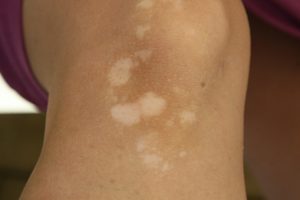 Vitiligo may increase thyroid disease risk and a new vitiligo treatment may help improve the skin discoloration caused by the disorder. Results from a systematic review and meta-analysis found that thyroid disease is a common comorbidity in vitiligo patients. The authors noted that, “thyroid disease has been suggested to be associated with vitiligo… the outcomes of prevalence studies on thyroid disease in vitiligo vary widely.”
Vitiligo may increase thyroid disease risk and a new vitiligo treatment may help improve the skin discoloration caused by the disorder. Results from a systematic review and meta-analysis found that thyroid disease is a common comorbidity in vitiligo patients. The authors noted that, “thyroid disease has been suggested to be associated with vitiligo… the outcomes of prevalence studies on thyroid disease in vitiligo vary widely.”
The researchers carried out a literature review and selected over 48 studies, which included 24,000 vitiligo patients. Of the selected studies, 33 reported thyroid disease prevalence among patients, 19 reported autoimmune thyroid disease, and 38 reported thyroid antibodies.
Advertisement
Overall, 15 percent of vitiligo patients had thyroid disease, 14.3 percent had autoimmune thyroid disease, and 20.8 percent tested positive for thyroid-specific antibodies.
Patients with vitiligo were 1.9 times more likely to have thyroid disease, 2.5 times more likely to have autoimmune thyroid disease, and 5.2 times more likely to test positive for thyroid-specific antibodies than individuals without vitiligo. The risk of thyroid disease increased with vitiligo disease duration.
The authors wrote, “Clinicians should be aware of the increased risk of thyroid disease in vitiligo patients and should be attentive [to] symptoms of thyroid disease. [However] to recommend… screening of autoimmune thyroid disease in euthyroid vitiligo patients more research on prevalence, cost-effectiveness, and burden of the patient is needed. Hence, future research of good methodological quality, with differentiation of vitiligo types and the use of standardized outcome measures, is recommended.”
Vitiligo skin discoloration improved with unique treatment
Researchers at UT Southwestern Medical Center have improved a technique to transplant pigment cells, which can help repair damaged discolored skin areas found in vitiligo. The new technique is less painful than traditional treatment that cuts into the skin to obtain the cells for transplantation. In the new treatment, cells are harvested from painless blister-raised skin and then transferred to the areas missing pigmentation to help restore natural pigment.
Dr. Amit Pandya, developer of the new technique, said, “This provides new hope for patients with vitiligo. The unique aspect of our procedure, which no one else in the world is doing, is the formation of blisters as the source of donor cells combined with laser surgery to prepare the grafted areas. The older method of cutting the skin leaves a scar.”
The procedure is done by applying a heat lamp to an area of the thigh to form a blister. With the help of a syringe, the cells are extracted from the blister and are later transplanted to the affected area. Dr. Pandya explained, “It doesn’t even hurt. It feels like something is sucking on your skin. Then using heat lamps we’re able to form blisters about the size of a dime.”
Blistering leaves pigmentation, which over time fades away. The extracted cells are then added to a solution in a syringe and added to the affected area. Dr. Pandya said, “The best candidates have improved with previous treatments, but have reached a standstill in which they are neither improving nor worsening.”
Many patients will see at least 50 percent improvement in skin pigmentation, but results are not guaranteed. The new pigmentation may be slightly lighter or darker, but this can be adjusted with phototherapy.
Aside from new vitiligo treatments, Dr. Pandya is also working on a possible cure for vitiligo by working closely with vitiligo registries.
Diet plays an important role in preventing vitiligo, see the vitiligo diet chart and foods to eat and avoid.
Related Reading:
Vitiligo patients face dry eye syndrome, other eye health risks
Vitiligo patients face dry eye syndrome along with other eye health risks. Significant differences were seen in vitiligo patients who underwent the Schirmer test, which determines if the eye produces enough tears for proper moisture. Continue reading…
Advertisement
Vitiligo linked to simultaneously existing autoimmune diseases
Vitiligo, an autoimmune skin condition, is linked to simultaneously existing autoimmune diseases. Researchers from St. Luke’s-Roosevelt Hospital Center created a questionnaire to be answered by children and adults who had vitiligo to determine other coexisting autoimmune diseases, which may appear along vitiligo. Continue reading…
Sources:
http://www.news-medical.net/news/20120810/Thyroid-disease-common-in-vitiligo-patients.aspx
http://onlinelibrary.wiley.com/doi/10.1111/j.1365-2133.2012.11198.x/abstract
